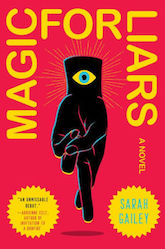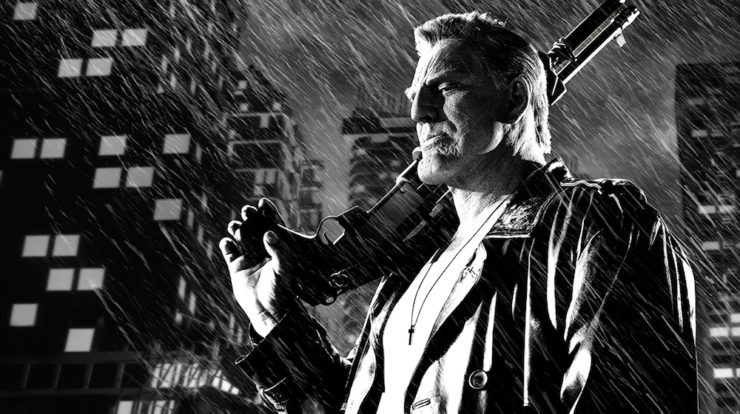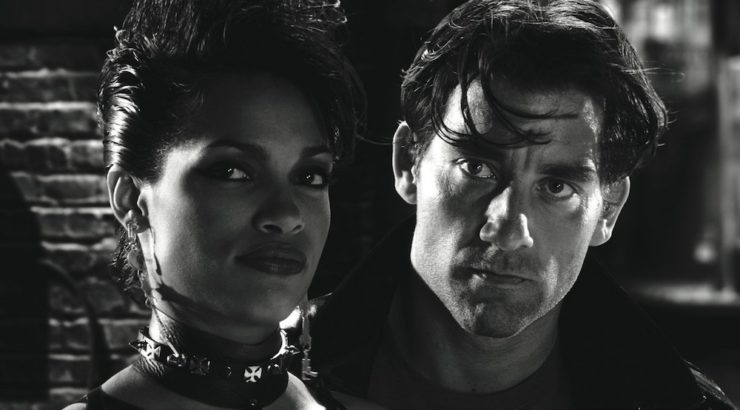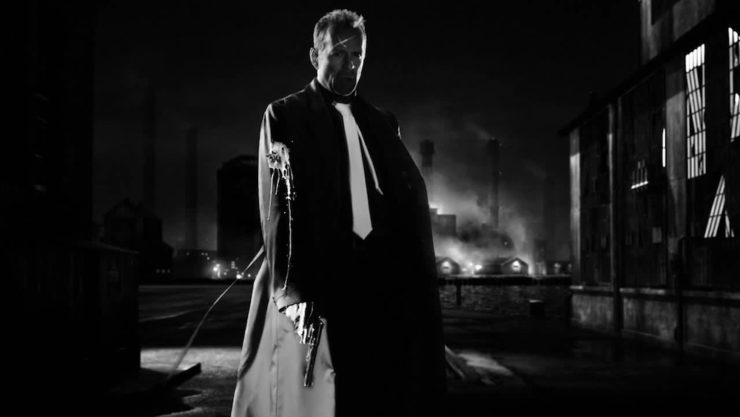By 1991, Frank Miller could pretty much write his own ticket in the comics industry. He almost single-handedly turned Daredevil from an obscure Spider-Man wannabe title on the verge of cancellation into one of the “it” books of the 1980s. He then told two Batman stories (The Dark Knight Returns and “Batman: Year One”) that have continued to be among the most influential Bat-stories ever told three decades later.
A fallout with DC over a ratings system led to Miller starting a relationship with Dark Horse Comics, and it was with them that he debuted Sin City in 1991.
Initially, the Sin City stories were told in Dark Horse Presents, the brilliant anthology comic the company started in 1986, and which also launched Paul Chadwick’s Concrete and John Byrne’s Next Men. The stories were successful enough (and collected in the trade paperback The Hard Goodbye) that Dark Horse launched a series of Sin City miniseries: A Dame to Kill For, The Big Fat Kill, That Yellow Bastard, and Hell and Back. There were also a series of one-shots (collected in Booze, Broads, & Bullets) and a graphic novel (Family Values).
Miller’s work always had a strong pulp feel, with heavy influence from the likes of Raymond Chandler’s fiction and James Cagney’s movies. With Sin City he decided to go full-on noir, to portray a vicious, nasty world where heroism wasn’t the norm, and even those few people who tried to do good struggled.
It’s a very literally black-and-white world, as Miller drew the comic with no gray at all, and only the occasional spot of color for effect. Otherwise it was just pure blackness and pure white, giving the book a very distinct look.
Basin City is a west-coast town, nicknamed Sin City, which grew during the 19th-century gold rush and these days is a haven of criminal activity—all the worst urban-nightmare stereotypes of cities like New York, Los Angeles, Chicago, and Detroit between 1971 and 1990 are embodied in Sin City. The city is also the true protagonist, as there is no one single character Miller follows (though many recur). The Sin City stories are anthologies, each telling stories about different characters and different aspects of the sleazy town.
Gun-shy after his horrible experiences as the screenwriter of RoboCop 2 and RoboCop 3, Miller was reluctant to get involved with Hollywood ever again. To convince him that he could do justice to Sin City, Robert Rodriguez did a “proof of concept” short called “The Customer is Always Right” with Josh Hartnett and Marley Shelton. (That short was integrated into the final film.)
Buy the Book


Magic for Liars
Rodriguez used a technique that was brand-new at the time he made it—only Sky Captain and the World of Tomorrow had done likewise—but is now commonplace in big-budget special-effects-heavy movies, to wit, filming in a “digital studio” where the actors are working almost entirely on a green-screened stage with the sets put in digitally in post-production.
Miller and Rodriguez are both credited as directors, and they did team up in the directorial chairs. The Directors Guild of America refused to accept the joint credit by a non-established directing team. Rodriguez intended to give Miller sole credit, but Miller refused to allow that, so Rodriguez resigned from the DGA and put them both in. Rodriguez’s friend Quentin Tarantino, listed as a “special guest director,” directed the scene of Clive Owen’s Dwight driving to the tar pits with Benecio del Toro’s Jackie-Boy’s corpse in the passenger seat.
Like the comic on which it’s based, Sin City is an anthology, adapting several of the individual comics stories. Besides the aforementioned “The Customer is Always Right” (adapted from the story in The Babe Wore Red and Other Stories), there’s also:
“The Hard Goodbye” (based on the original set of serialized stories in DHP; the special-edition DVD of Sin City includes a reprint of this storyline in a small graphic novel) starring Mickey Rourke (last seen in this rewatch in Iron Man 2), Jaime King (last seen in this rewatch in The Spirit), Carla Gugino (last seen in this rewatch in Watchmen), Elijah Wood, Rutger Hauer (last seen in this rewatch in Batman Begins), and Miller himself.
“The Big Fat Kill” (based on the second miniseries Miller did) starring Clive Owen (who will next be seen in this rewatch in Valerian and the City of a Thousand Planets), Benecio del Toro (last seen in this rewatch in Thor: The Dark World and Guardians of the Galaxy), Rosario Dawson (last seen in this rewatch in Men in Black II), Michael Clarke Duncan (last seen in this rewatch in, ironically, Daredevil), Alexis Bledel, Devon Aoki, Brittany Murphy, Patricia Vonne, Nicky Katt (last seen in this rewatch in Batman & Robin and The Dark Knight), Clark Middleton, and Tommy Flanagan (who will next be seen in this rewatch in Guardians of the Galaxy Vol. 2).
“That Yellow Bastard” (based on the third miniseries Miller did) starring Bruce Willis, Jessica Alba (last seen in this rewatch in Fantastic Four and its sequel Rise of the Silver Surfer), Nick Stahl, Powers Boothe (last seen in this rewatch in Avengers), Michael Madsen, Makenzie Vega (last seen in this rewatch in X-Men: The Last Stand), Jude Ciccolella (last seen in this rewatch in Daredevil), Rick Gomez (last seen in this rewatch in 1990’s Teenage Mutant Ninja Turtles), and Nick Offerman.
(For the record, prior to 2005, if anyone asked me who I thought would be the best actors to play male Frank Miller characters, the first three names out of my mouth would’ve been Bruce Willis, Michael Madsen, and Mickey Rourke, so I find it particularly hilarious that all three are actually in the movie, though I would’ve pegged Madsen for having a bigger role.)
Rourke, Alba, Dawson, Willis, Boothe, King, Ciccolella, and (in different roles) Vonne and Miller will all appear in the 2014 sequel, which we’ll cover next week.
“Sometimes the truth doesn’t matter like it ought”
Sin City
Written and directed by Frank Miller & Robert Rodriguez
“Special guest director” Quentin Tarantino
Produced by Elizabeth Avellán
Original release date: April 1, 2005

A man meets a woman in a red dress on a rooftop patio just outside a party. He tells her that he’s been following her and finds her intoxicating and beautiful, and, rather than call security to have this creepy stalker guy escorted out, she falls into his arms. He promises to take her away from her problems and run away with her—then he shoots her with a silencer, and she dies in his arms. He concludes his voiceover by saying that he’ll cash her check in the morning—not only is he a hitman, but his client and target are both the woman he just shot, who apparently included role-playing in the fee.
For his last day on the job before being forced into retirement thanks to his heart condition, Detective Jake Hartigan goes to rescue a little girl named Nancy. She’s the latest victim of Roark Junior, the son of Senator Roark, and nephew of Cardinal Roark. The Roark family is by far the most powerful in Basin City, a.k.a. Sin City, which is how Junior can get away with kidnapping, raping, and killing underage girls. Hartigan has had enough, and it being his last day on the job, figures he has nothing to lose.
His partner, Bob, tries to stop him, and Hartigan punches him out. He goes to rescue the girl, with Junior insisting he’s untouchable. Hartigan touches him anyhow, shooting him in the hand and then in his groin, thus eliminating both of his weapons. But then Bob shoots Hartigan in the back. Hartigan falls unconscious, grateful that at least he saved Nancy.
Marv is a big, ugly lummox who finds himself in bed with Goldie, a beautiful blonde. He wakes up the next morning to find her dead. The cops arrive to arrest him for her murder, but he escapes, leaving several cops hospitalized. He goes to his parole officer’s house—Lucille, the PO in question, gives him meds (and also parades around nude) and lets him hide out for a bit.
Against Lucille’s advice to lay low, Marv goes to Kadie’s Bar, and then works his way through various thugs, informants, and lowlifes (as well as a priest), which leads him to the Roark family farm outside town. At one point, he sees a woman shooting at him who looks just like Goldie, but he assumes it’s a hallucination. He later finds out that it’s Goldie’s twin sister Wendy. Eventually, Wendy realizes that Marv didn’t kill Goldie, and she helps him.
At the Roark farm, Marv is attacked by a young man who moves quickly and silently, subduing Marv and imprisoning him with Lucille, whose left hand has been chewed off—it turns out by Kevin, who is a cannibal. Marv manages to break out of their cell with his brute strength just as the cops—all on Roark’s payroll—arrive. Lucille tries to negotiate for Marv to be brought in peacefully, but the cops’ response is to shoot her down. Marv takes down the cops, and then kills Kevin the same way he killed his victims, one body part at a time—though Kevin never screams, to Marv’s frustration.
Marv takes Kevin’s head to Cardinal Roark, Kevin’s mentor and protector, and then tortures him to death. Marv is arrested and sentenced to death. The first time they try to electrocute him, it doesn’t take.
Back at Kadie’s, a guy named Jack hits on Shellie, refusing to accept that they’ve broken up. Shellie’s current boyfriend, Dwight, is not happy about this, and when Jackie-Boy shows up with his friends at Shellie’s apartment, Dwight beats him up and shoves his head in an unflushed toilet.
Annoyed, Jackie-Boy gets in his car and drives to Old Town. Dwight follows, despite Shellie’s urging not to—a helicopter is flying overhead as he departs, so he thinks she says to stop.
Old Town is run by the local prostitutes. They enforce the law there. The cops leave them alone and they police their own. Jackie-Boy shows up to try to buy Becky’s services, but she’s tired and is off-shift and wants to go home. Jackie-Boy doesn’t take no for an answer, and gets violent.
That sets off Gail, the leader of the prostitutes. She sends in Miho, a silent martial artist who uses swords and shuriken shaped like swastikas (yes, really). She kills Jackie-Boy and his friends. As they go through their pockets, they find Jackie-Boy’s wallet: he’s actually Lieutenant Jack Rafferty, a decorated Basin City police officer. (Belatedly, Dwight realizes that Shellie was trying to tell him that Jackie-Boy was a cop.) This will kill the truce between the cops and the prostitutes—things will go back to the bad old days of pimps and abuse of the women.
Sure enough, a mob enforcer named Manute arrives looking for Jackie-Boy’s body to take to the cops as proof that they broke the truce. Manute was summoned by Becky, who betrayed her fellow prostitutes for money and to protect her mother. Dwight is taking the bodies to the tar pits, where the cops will never find them. However, Manute has hired some Irish mercenaries, who attack Dwight and try to take the body back. A grenade goes off and sends the car and Dwight into the tar pits. The mercs manage to cut off Jackie-Boy’s head, which is proof enough.
Miho and Dallas rescue Dwight from the pits, and manage to kill the mercs and get the head back. They go back to Old Town and offer the head to Manute in exchange for Gail. Gail isn’t happy about that deal, but Manute takes the head, gives him Gail, and then prepares to kill both of them anyhow.
Dwight then sets off the grenade he put in Jackie-Boy’s mouth. The evidence that the prostitutes kills a cop is destroyed, and then the rest of Gail’s women show up and shoot down Manute and his people. Becky manages to lay low and survive.
Hartigan survived being shot and Senator Roark pays him a visit in the hospital. The senator is paying for all of his care, even having his heart condition cured—and making sure that Hartigan takes the fall for the attack on Nancy, including raping her, and also for the assault on Junior. Nancy visits him once in the hospital, saying that nobody believes her story, and nobody even checks to see if she’s been raped (she hasn’t). Hartigan urges her to never visit him again, though she does write him under a false name.
For eight years, Hartigan languishes in prison, his only contact from the outside the pseudonymous letters from Nancy. Then the letters stop. A few weeks after that, an envelope shows up with a finger in it.
Hartigan confesses to everything, which somehow gets him released. Bob meets him at the prison and takes him home, telling him that his wife remarried and has two kids. Hartigan tracks Nancy down, only to find that she’s working as an exotic dancer at Kadie’s. She also has all her fingers.
Belatedly, Hartigan realizes that the finger was a bluff to get him to confess, be released, and lead Roark’s people to Nancy. Or, more specifically, Junior, whose skin is now horribly jaundiced after all the medical treatments he received following Hartigan shooting off his hand and genitals. Hartigan and Nancy escape to a motel, but Junior tracks them down, and kidnaps Nancy. Hartigan follows them to the Roark farm, where he again shoots his hand and this time rips out his surgically repaired genitals, leaving him for dead.
Hartigan sends Nancy away, promising to put Roark behind bars. She leaves, and then—knowing that Roark is too powerful to ever see justice—he shoots himself in the head, as that’s the only way Nancy will be safe.
Becky is leaving the hospital where her broken arm is being treated. She enters an elevator to find the assassin from the very first scene waiting for her.
“She doesn’t quite chop his head off—she makes a Pez dispenser out of him”

As an adaptation of a comic book, this may be the most perfect one ever done. Rodriguez and Miller do an amazing job of re-creating the Sin City comics stories, not just in terms of the heavily stylized visuals, but also the noir tone of the original. This isn’t just Zack Snyder soullessly using the comic book as a storyboard the way he did with Watchmen and his adaptation of Miller’s 300; this isn’t Mark Steven Johnson trying to recapture Elektra’s death in Daredevil #181 and failing or Taika Waititi trying to recapture Skurge’s death in Thor #382 and failing.
No, Rodriguez and Miller have made a movie that is still works as a movie while being 100% faithful to the source material in a way rarely seen before or since.
It’s just too bad the source material isn’t all that great.
Part of the problem is that this stuff reads way better than it sounds. The cheesy pulp dialogue is stronger written down than it is coming out of an actual human mouth, and while some of the actors manage to sound convincing uttering this hard-boiled nonsense (Rosario Dawson, Mickey Rourke, and Powers Boothe handle it best; Carla Gugino, Michael Madsen, and Brittany Murphy handle it worst), it mostly doesn’t sound like people talking so much as reading dialogue. Miller’s stylized artifice is better suited to the page than it is to the screen. For one thing, hearing it spoken aloud makes you realize how repetitive a lot of it is. (If I had to hear Hartigan call himself “old man” one more time…)
The other problem is the same one that Sin City has generally—one which will be exacerbated by the 2014 sequel—in that there’s really only three characters and one plot here. Women are mostly sex workers of some sort, or at the very least fetishized and/or male-gazed into oblivion. Even the most competent ones are there only in terms of how they service and/or are used by the men, and in the end it’s always the macho tough dude who saves the day—and saves the women, who are incapable of saving themselves.
And the men are all either total deviants or macho tough guys. Or both. There’s no qualitative differences among the three male leads, as Bruce Willis’s Hartigan, Clive Owen’s Dwight, and Rourke’s Marv are basically the same guy: tough, protective of women, full of bluster, and apparently are able to get shot over and over again with only minor ill effects. The only one who stands out is Marv, partly because he has a physicality the others don’t, which Rourke plays beautifully.
The story is always the same: macho tough guy does battle against an asshole to defend a hugely sexualized woman.
The Marv sequence, “The Hard Goodbye,” works best, much as it did in the comics, as it was the first, so the repetition hadn’t set in yet. In this movie in particular it mostly functions on the strength of Rourke’s so perfectly inhabiting Miller’s overmuscled, underbrained protagonist. Elijah Wood is also superb as the beatific, athletic Kevin. As for the rest of it, Willis was pretty much born to play a Miller protagonist, Dawson is obviously having the time of her life as Gail, and Devon Aoki is superbly deadly as Miho. The rest of the cast is surprisingly mediocre. One doesn’t expect all that much from Murphy or Josh Hartnett, but Owen, Gugino, Madsen, Michael Clarke Duncan, and Benecio del Toro are all blander than you’d expect.
Ultimately, this is a bit too much of a throwback to a time that is simpler in the worst possible sense. In fact, the only thing that feels like it belongs in this century is Senator Roark’s speech to Hartigan—frighteningly delivered by Boothe—about how true power isn’t money or strength, but in making people believe a lie. It has frightening resonance today…
Sin City did more than well enough to get a sequel, though it took nine years. (In the interim, Miller vomited The Spirit onto an unsuspecting public.) Next week we’ll take a gander at A Dame to Kill For.
Keith R.A. DeCandido is an author guest at Balticon 53 this weekend, alongside various author, editor, artist, agent, podcaster, and costuming guests, including Guests of Honor Elizabeth Bear, Scott Lynch, Charles Vess, the Bibbering Humdingers, Nicky Drayden, Gregory Benford, and R.F. Kuang, and also Ghost of Honor, the late Jack L. Chalker. Keith will be launching Mermaid Precinct Sunday night at the show, and will be spending much of his time at the eSpec Books booth. He’ll also be doing programming and a reading—see his full schedule here.










